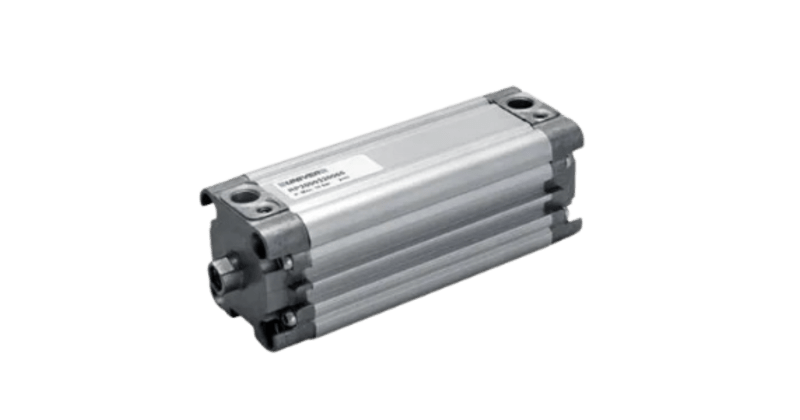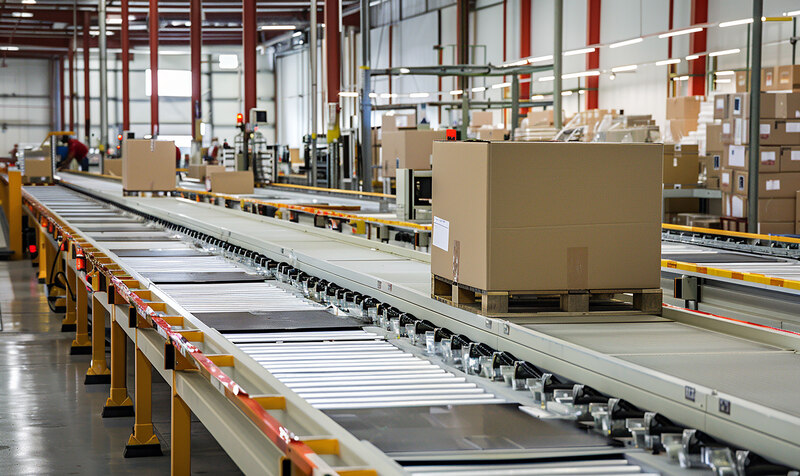Pneumatic Cylinders for Power & Versatility in Automation

In process automation, the right components make all the difference to ensure smooth and efficient operations. One such component that has remained a popular solution over the years due to its power and versatility is the pneumatic cylinder.
Also known as pneumatic linear drives, air rams, air cylinders, or simply pneumatic cylinders, these mechanical devices have proven their adaptability and reliability in a wide range of applications, including simulating explosions, moving heavy loads, and automating processes.
In this blog post, we’ll talk about pneumatic cylinders, their working principles, advantages, types, and applications. We’ll also highlight how MasterMac2000 can help you find the perfect air cylinder solution for your specific needs.
What Are Pneumatic Cylinders?
Pneumatic cylinders are mechanical devices that utilise compressed air to generate linear motion. They consist of a cylinder, a piston, and a rod. When compressed air is introduced into the cylinder, it pushes the piston, which in turn moves the rod, creating a powerful linear force.
These devices are often compared to hydraulic cylinders, which use pressurised liquid instead of air. However, pneumatic cylinders offer several advantages over their hydraulic counterparts, including:
- Faster operation
- Cleaner and more environmentally friendly
- Lower maintenance requirements
- Safer operation due to lower pressures involved
But How Do They Really Work?
At its core, a pneumatic cylinder consists of a piston that moves within a sealed cylinder barrel in response to compressed air. The compressed air enters the cylinder through ports, causing the piston to extend or retract, depending on the design and configuration of the cylinder.
The force generated by the piston is determined by the pressure of the compressed air and the bore size of the cylinder. The larger the bore, the greater the force output for the same pressure. This simple yet effective mechanism allows pneumatic cylinders to perform a variety of tasks, such as pushing, pulling, lifting, and lowering, with precision and reliability.
Pneumatic Cylinders Offer Many Advantages
Pneumatic cylinders provide numerous benefits that make them an attractive choice for process automation applications:
- Compact size – Air rams can have a small footprint, making them ideal for applications where space is limited.
- High force output – Despite their compact size, pneumatic air cylinders can generate significant force, thanks to the power of compressed air.
- Durability – With fewer moving parts and no need for lubrication, air rams are highly durable and require minimal maintenance.
- Precision control – Pneumatic cylinders offer excellent precision and repeatability, ensuring consistent performance in demanding applications.
- Cost-effectiveness – Compared to other actuation technologies, air rams are relatively inexpensive, making them a cost-effective solution for many industries.
Types of Pneumatic Cylinders
There are two main types of pneumatic cylinders: single-acting and double-acting.
1. Double-Acting Cylinders
These cylinders are the most commonly used type, accounting for nearly 95% of all cylinders in pneumatic control systems in manufacturing. Double-acting cylinders have two ports, one at each end, allowing compressed air to move the piston forward and backwards by alternating the port receiving the air. The thrust force is generated in both extending and retracting directions.
Advantages of double-acting cylinders include:
- Extensive range of bore and stroke sizes
- Many variations available based on the design
- ISO standards (e.g., ISO 15552, ISO 6432, ISO 21287) include specifications for double-acting cylinder designs
Disadvantages include:
- Inability to hold a mid-position without complex control circuits of mechenical braking.
- Requirement of pressure to return the piston rod
2. Single-Acting Cylinders
Single-acting pneumatic cylinders have only one port for compressed air to enter. The thrust force is generated in one direction, and the piston is returned to its original position by a fitted spring, weight, gravity, or external mechanical movement. These cylinders are commonly used in applications such as clamping, positioning, marking, stroking, and light assembly operations where force is required in only one direction.
Advantages of single-acting cylinders include:
- Simple design
- Compact size (mini cylinders are available for an even smaller size)
- Reduced piping and valve costs
- Lower air consumption compared to double-acting cylinders
However, they also have some limitations:
- Limited bore size and stroke due to spring size and force
- Potential entry of foreign matter through the vented spring, leading to malfunctioning
- Inconsistent spring operation over extended periods
- Slightly reduced thrust due to opposing spring force
How to Choose the Right Pneumatic Cylinder
When selecting a pneumatic cylinder for your application, there are several factors to consider, such as:
- Bore size – The bore size (typically measured in mm) determines the cylinder’s force output. A larger bore will generate more force for a given air pressure.
- Stroke length – The stroke length is the distance the piston travels inside the cylinder. It should be chosen based on the required range of motion for your application. Long strokes generally require external guiding.
- Mounting options – Standard cylinders come with various mounting options, such as flanges, trunnions, or clevis mounts, to suit different installation requirements.
- Operating pressure – The operating pressure of the cylinder should match the available air supply pressure in your system.
- Cushioning – Cushioning options, such as adjustable cushions or shock absorbers, can be added to reduce impact forces and extend the cylinder’s life.
- Space constraints – For applications with limited space, pneumatic compact cylinders and rodless cylinders offer a powerful yet space-saving solution for linear motion.
Consider Force Output and Speed Considerations as Well
It is especially important to consider the force output and speed requirements when selecting a pneumatic cylinder for a specific application.
The force generated by a pneumatic cylinder depends on the air pressure and bore size. Manufacturers often provide push and pull values in their catalogues for both single-acting and double-acting cylinders to simplify the calculation process for users. It is important to note that doubling the bore size quadruples the thrust force for the same giver pressure supply.
The speed of a pneumatic cylinder is another critical factor affecting its performance and durability. Port sizes, inlet and exhaust flow through hoses, tubing sizes, and control valves can all influence the velocity of an air ram. Proper dimensioning and flow considerations are essential to ensure optimal performance and longevity of the pneumatic system.

Applications of Pneumatic Cylinders
Pneumatic cylinders find applications across a wide range of industries due to their versatility, reliability, and cost-effectiveness. Some common applications include:
Manufacturing and Packaging
Pneumatic cylinders are extensively used in assembly lines, material handling, and packaging processes. They enable precise positioning, clamping, and movement of products and components.
Food Processing
Air rams are employed in food processing plants for tasks such as sorting, filling, and sealing. Their compact size and hygienic design make them suitable for use in food-grade environments.
Automotive Industry
Pneumatic cylinders play a crucial role in automotive manufacturing, from assembly and welding to material handling and quality control. They offer high speed, accuracy, and repeatability, ensuring efficient production processes.
Construction and Mining
Pneumatic cylinders are used in construction and mining equipment, such as jackhammers, drills, and excavators. They provide the necessary force and durability to handle demanding tasks in harsh environments.
Optimise Your Automation With Premium Pneumatic Cylinders From MasterMac2000
Pneumatic cylinders have revolutionised process automation by offering a powerful, versatile, and cost-effective solution for linear motion applications. With their simple design, clean operation, and wide range of configurations, these cylinders have become an indispensable tool for industries across the globe.
When it comes to sourcing high-quality pneumatic cylinders and other automation components in Australia, MasterMac2000 stands out as the leading supplier. With over 30 years of experience, we have built a reputation for providing top-notch products from renowned brands like Univer, Mack, Tolomatic, and Piab. We can help you select the right cylinder based on your specific requirements and budget.
To learn more about how MasterMac2000 can help you with your pneumatic system requirements, contact us today at (07) 3344 4711 or [email protected]. Let us help you take your automation to the next level.

About MasterMac2000: Your Trusted Pneumatic & Process Automation Partner.
LEADING THE INDUSTRY: Established in 1989, MasterMac2000 has grown to become one of Australia's largest privately owned pneumatic and process automation companies. We stock top-quality brands like Univer, Mack, Tolomatic, Mac, Piab, American, and Rotoflux in Brisbane.
SERVING QLD & NORTHERN NSW: We proudly service Queensland and Northern New South Wales for all your pneumatic and process equipment needs. Our mission is to provide the best pre and post-sales support while actively expanding our client base.
SOURCING HARD-TO-FIND PARTS: Not only do we stock quality components, but we also excel at sourcing those elusive, hard-to-find parts. With our extensive database and global network of contacts, getting the parts you require is as easy as a call to our highly skilled, professional sales team.
DEDICATED TO YOUR SUCCESS:
- Decades of expertise in pneumatics & process automation
- Carefully curated selection of world-class brands
- Exceptional sourcing capabilities for speciality parts
- Knowledgeable sales staff dedicated to finding solutions
- Unwavering commitment to customer service excellence
About The Author
Stuart Havill
Stuart Havill is the owner and manager of MasterMac2000, Queensland's largest privately owned pneumatic and process valve company.
With his early working career as a maintenance fitter for Boral in 1992, Stuart has spent his life in the field of pneumatics and process equipment. He gained extensive experience in plant design, maintenance, repairs, fabrication, and site management.
In 1996, he transitioned to a pneumatic sales technician role at MasterMac2000, where he excelled in key account management, providing cost-effective solutions, and managing a sales team of 9 employees.
Since 2002, Stuart has been the manager at MasterMac2000, overseeing the company's growth and establishing it as a leader in pneumatic automation and process valve engineering. His expertise spans customer training, CRM setup, industrial compressor sizing and installation, and turn-key project management.
Under Stuart's leadership, MasterMac2000 has been servicing the industry since 1988, with 5 full-time sales representatives covering northern rivers NSW, Queensland, Northern Territory, and PNG. The company prides itself on providing the best-priced solutions to all customers in the marketplace.
View Stuart’s LinkedIn profile to learn more about his expertise in pneumatics and process equipment.